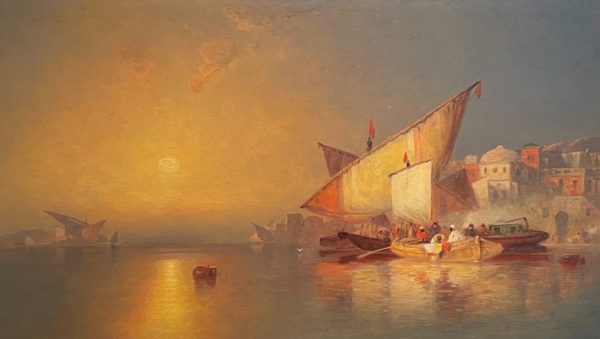The landscape painter George Washington Nicholson was born near Salem, New Jersey in 1832. As a boy Nicholson lived in Mannington Township. By the age of 17 he was apprenticed to a house painter named Daniel Woodruff in Salem. According to family tradition, he was encouraged in his artistic pursuits by his oldest sister, Rachel, and probably began painting in the 1850s.
Nicholson moved to Philadelphia sometime before 1861, the year he married a young woman named Jane Elizabeth Bray, known as Jennie. He may have met Jennie through her father, Job F. Bray, who had worked as a sign painter in Philadelphia for many years. It seemly likely that Nicholson worked as Bray’s apprentice. Jennie died in 1963 after the birth of George F. Nicholson, their first and only child.
Nicholson’s art career was launched in earnest by 1862, the first year his name appeared in Philadelphia city directories with the designation “Artist.” By the early 1860s he was teaching art in Philadelphia, most likely in the form of private lessons. At least one younger painter, James Brade Sword, is believed to have studied with him between 1861 and 1863. Nicholson is also thought to have given painting lessons to Joseph Sorver, the businessman Harrington Fitzgerald, the photographer and artist A. N. Lindenmuth, and the actor and amateur artist Joseph Jefferson.
Around 1865, Nicholson may have studied informally at the Pennsylvania Academy of the Fine Arts in Philadelphia, where he was elected an Associate Artist on April 3, 1865. Like many American artists of the day, he went abroad for additional training, visiting England and France in 1866. Further travels are unconfirmed, although his landscape subjects include a variety of foreign sites including Holland, Germany, Italy, and Egypt. In Paris he studied, again perhaps on an informal basis, with Eugene Isabey.
Nicholson spent the rest of his professional career in Philadelphia. He exhibited at the Pennsylvania Academy only once – in 1867 – with a landscape titled Sketch from Nature, Looking Towards Windsor Castle. While establishing himself as an artist he supplemented his income with engraving, a trade he may have learned from his brother-in-law John Bray.
A very private individual, Nicholson seldom participated in artists’ organizations of the era. His work was exhibited in Philadelphia at Haseltine Art Galleries and included, at least once, at The Union League Club (1873). He also sent canvases to exhibitions at the National Academy of Design (1874) and the Brooklyn Art Association (1875, 1876). Although Nicholson seldom exhibited in New York City, his work was often included in more modest regional venues. He sent paintings to exhibitions at the Art Association of Montreal (1870), the Detroit Art Association (1875-76), and the Chicago Academy of Design (1876). He was also an associate member of the Northwest Gallery of American Art (possibly located in Chicago).
Nicholson also exhibited at a variety of agricultural and industrial fairs: the Agricultural and Mechanical Association, St. Louis (1870); the St. Louis Mercantile Library (1871, 1872); the Cincinnati Industrial Exposition (1872); the Chicago Interstate Industrial Exposition (1874, 1876); and the Louisville Industrial Exposition (1875, 1877, 1880).
The peak of the artist’s career occurred in the 1890s. One of his largest commissions was a mural titled The Old Homestead, which was finished in March 1892 and placed on display at Wanamaker & Brown, the famous Philadelphia department store located at Sixth and Market Streets. (Its location is unknown today.) A version of The Old Homestead was also used in a very different sort of commission: to decorate the label of Canavan’s Old Homestead Whiskey. Another mural, Washington Crossing the Delaware, was painted for the Pennsylvania State House in Harrisburg and may have been lost when the old State House burned in 1897.
Nicholson’s early trip abroad provided an unending source of subjects for his brush. Throughout his career he alternated foreign landscapes with occasional American scenes and literary subjects, painting in both oil and watercolor. Nicholson usually signed his paintings; he seldom dated them, however, so forming a precise chronology is difficult. Establishing dates for the paintings is further complicated by the fact that many of his canvases follow compositional formulas he repeated throughout his career.
Nicholson’s patrons included a variety of well-to-do individuals such as judges, lawyers, doctors, and businessmen. His most supportive patron was Alfred O. Deshong, a businessman from Chester, Pennsylvania, who collected 20 paintings. Those works are now at the Widener University Art Gallery and Collection.
Recent research indicates that Nicholson moved to Camden around 1890, while continuing to maintain a studio in Philadelphia. Around 1895 he moved back into Philadelphia. In 1902 he received a gold medal at the American Art Society for a painting titled Harvest Field in Berks County. Seventy years old at the time, he may have received the award in recognition of his long career as a Philadelphia painter.
Around 1902 Nicholson retired to Hammonton, New Jersey, where his son had settled some fifteen years earlier. He lived in Hammonton until his death in 1912 at the age of 80.

